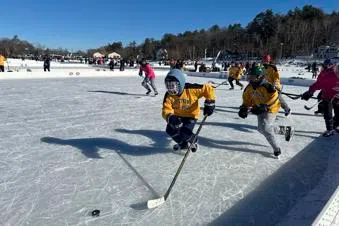
FILE - Hockey players go for the puck during the final of the women's open division at the pond hockey classic in Meredith, N.H., on Sunday, Feb. 4, 2024. (AP Photo/Nick Perry, File)
MINNEAPOLIS (AP) — Calls from the U.S. to Roustan Hockey headquarters in Canada in recent weeks have been anything but routine, as bulk orders of name-brand sticks have suddenly become complicated conversations.
“These customers want to know: When their orders ship, will they have to pay an additional 25% tariff? And we respond by saying, ‘Well, right now we don’t know, so they postpone their order or cancel their order because they want to know before they order what the cost is going to be,” said Graeme Roustan, who owns the company that makes and sells more than 100,000 hockey sticks annually to the U.S. market.
The prospect of 25% tariffs by President Donald Trump on Canadian imports, currently paused for some goods but facing full implementation on Wednesday, has caused headaches if not havoc throughout the commercial ecosystem. The sports equipment industry is certainly no exception, with so many of the products manufactured for sports -loving Americans outside of the U.S.
No two countries in the world are intertwined athletically more than Canada and the U.S. are with hockey, either, making mere talk of a trade war a spreadsheet-shuffler — and potentially a budget-buster — for businesses based around the rink and the consumers of their products.
Roustan Hockey bought the Christian and Northland brands that originated in Minnesota and now manufactures them with other products under its umbrella in Brantford, Ontario, the town where Wayne Gretzky grew up about 60 miles southwest of Toronto. About 40% of Roustan’s business is with the U.S. market, and about 90% of sales of Christian and Northland gear go to American customers.
“Our business with the U.S. is steady right now because people are trying to get their orders in before the tariffs take effect, but I’m very concerned that once the tariffs go into effect that there will be people in, say, Minnesota who will think twice about buying a Christian or a Northland stick because of the 25% tariff,” Roustan said in a phone interview. “So the unknown is still unknown.”
Many pieces of retail hockey equipment originate in Asia, including China. Mexico is another player in the market, home to a factory for Warrior brand sticks, for example. Those countries are in the tariff crosshairs, too.
“Whether it’s in effect for a week or gets retracted or whether it’s a future date where we’re going to have some announcement, all that makes it very challenging to run and operate a business,” said Todd Smith, the chief executive officer of the Sports & Fitness Industry Association. “The general viewpoint is uneasiness and confusion.”
Roustan bought Bauer’s hockey outfitting business from Nike in 2008 and oversaw that company for four years. By the time Roustan assumed control, he said, Bauer — born in Canada in 1927 and a ubiquitous name in the sport — had shifted all of its manufacturing sites to Asia for cost savings on labor and facilities.
“The industry has done an admirable job of manufacturing across the globe while doing as much as they possibly can domestically,” Smith said. “The components made internationally are made internationally because we don’t have the manufacturing capability in the U.S. and we don’t have the workforce.”
In hockey, of course, a lot of gear is required to take the ice. That gear is also notoriously expensive, which puts this sport as subject to the tariff tumult as any. Just in North America, hockey equipment is a $1.3 billion business and growing, as estimated by Grand View market research. Any added cost from the import tax will almost certainly trickle down to the consumer.
Organizations like SFIA have long had an eye on rising costs of youth sports, concerned about the effect on participation and driven to increase accessibility to all activities in underprivileged communities.
“If folks aren’t aware of it now, they should be well aware that tariffs are bad for sports across the board,” Smith said.
The shows will still go on, tariffs or not
Most families with kids in sports are busy enough shuttling those young athletes to practices and shopping for the next round of gear that topics like international politics, global economics and commercial supply chains usually get the backseat.
Tariffs might drive up the price of hockey sticks? Well, just add that to the pile.
For Jeremiah Lamont and his family in Minneapolis, staying on top of the equipment inventory for two hockey-playing boys is enough of project on its own. Paying for it is another story, as his 12-year-old son Max enters each new stage of competition.
“The youth skates cost about $200. Well, his foot grows a half-inch, he can’t get into the youth ones, and now those same skates are $450,” Lamont said, estimating the current total cost of gear at more than $1,500, some of which must be annually replaced.
Ice time and travel costs sold separately, of course.
“He likes it. It’s good for him. So we just figure, ‘Why not?’” Lamont said.
The sticker shock is real for hockey newbies, as Kelley Baer and her family found out when now-13-year-old Brian got going on the ice. Sticks, skates, helmets, shin guards, elbow and shoulder pads, chest protectors, neck guards, they all add up.
Those sticks don’t always last the season, either, that vital-yet-fragile piece of equipment perpetually at risk for fracturing from an awkward hit — or in a moment of frustration. In the NHL, a replacement is always at the ready. A pile of sticks is a luxury most young players don’t have.
“I’m like, “No, no, no, no, no! That is a $400 stick. Do not slam that thing on the ice!” Baer said. “We always laugh about that, but it’s also very serious. We used it as a gateway of a conversation about showing your emotions on the ice and how you’ve got to be able to contain that as a leader. If you start losing your mind and slamming your stick, that’s a disadvantage for you.”
The life lessons in sports run as deep as the passions that fuel this giant slice of economy and culture.
“Yes, it’s expensive and we are fortunate in that we can afford it,” Baer said. “He’s our kid, and we love him. We want to support him in what he wants to do, and we’ll figure out a way.”




Comments